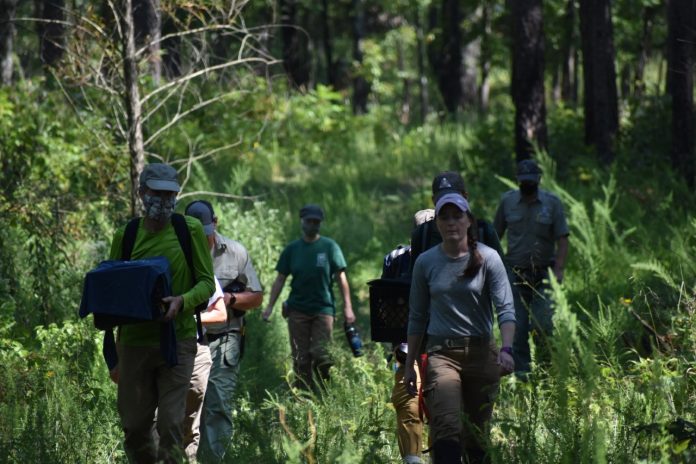It weighs in at one-third of an ounce, approximately the same as the combined weight of a nickel and a quarter, but the arrival of the Brown-headed Nuthatch in Missouri is nevertheless a weighty event. A collaborative forest restoration project culminated last week with the release of 25 Brown-headed Nuthatches in restored pine woodlands on the Mark Twain National Forest, marking the bird’s return to Missouri after being locally extinct for more than century.
“The goal of our research is to deliver the knowledge and tools that managers need for conservation,” said Frank Thompson, a research wildlife biologist with the USDA Forest Service’s Northern Research Station in Columbia. “However, we don’t often get to have such an immediate benefit to a species and ecosystem as restoring a population in an effort like this.”
Approximately 6 million acres of shortleaf pine and oak woodland once covered Missouri’s Ozarks; today, that ecosystem covers closer to 100,000 acres. Work by the Mark Twain National Forest to restore shortleaf pine and oak woodland accelerated in 2012, when the Forest and partners were selected by the Chief of the Forest Service for the Collaborative Forest Landscape Restoration Program (CFLRP). The CFLRP included 100,000 acres on the Eleven Point and Poplar Bluff Ranger Districts of the Forest as priority landscapes for restoration. The CFLRP includes State, Federal, and NGO partners and is restoring woodlands on multiple ownerships in the state. The Mark Twain National Forest site was chosen for the release because it is the largest area of open pine woodlands in the state.
“This project demonstrates the power of shared stewardship,” said Mark Twain National Forest Supervisor Sherri Schwenke. “It took all of our expertise to bring the Brown-headed Nuthatch home, just as it takes all of us working together to accomplish everything we do in terms of restoration, recreation and timber.”
Returning a native species to Missouri is one of many benefits of the CFLRP. “This program has allowed the Forest to meet the amount of thinning, prescribed fire, and other restoration objectives identified in the current Forest Plan at a much faster pace,” said Brian Davidson, Botany and Invasive Species Coordinator and one of many Mark Twain National Forest employees who has been heavily involved in implementing the project for the past 8 years.
Thompson’s research shows that many birds benefit from woodland restoration in Missouri, but the Brown-headed Nuthatch was still missing from this ecosystem as a result of its extirpation in the early 1900s. A team led by Thompson, Sarah Kendrick from the Missouri Department of Conservation and Tom Bonnot from the University of Missouri determined that sufficient woodlands now exist in Missouri to support a population of Brown-headed Nuthatches, that populations in Arkansas were robust enough to supply birds to Missouri, but that nuthatches are not likely to make the return on their own because of the distance and habitat fragmentation. They coordinated an effort involving state and federal partners in both Arkansas and Missouri to capture nuthatches on the Ouachita National Forest in Arkansas, fly them to Missouri, and release them in the Mark Twain National Forest. Twenty-five birds were released last week with the hope to release more in the next week and 50 again next year. Half of the birds are being tagged with tiny radio-transmitters that allow scientists to track their movements. “So far the tagged birds are moving around exploring the woodlands and socializing in small groups as we would expect them to. All indications are they are doing great,” Thompson said.
Missouri’s restoration is part of a roughly 1-million-acre natural communities restoration target for Missouri, Arkansas and Oklahoma on public lands.
“This effort is a great example of how when you bring back the habitat, you can bring back some of the species that were lost,” said Sarah Kendrick, State Ornithologist with the Missouri Department of Conservation.






